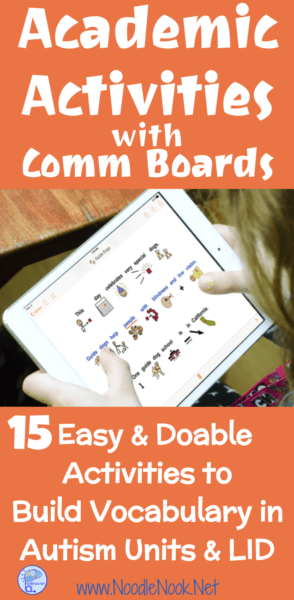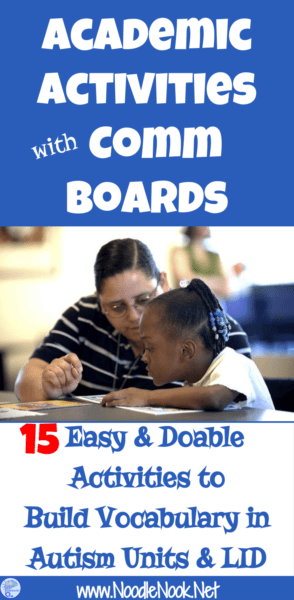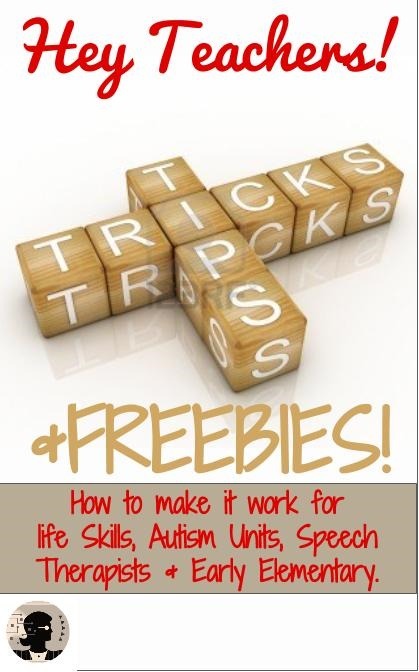I was in a LIFE Skills classroom last week and the teacher told me she never used the Communication Boards that came with the adapted stories. I gasped.
What a waste!
There a literally more than a dozen activities you can do with a Comm Board. Don’t believe me? Read on!
Academic Activities with Comm Boards
First off, for those of you who are new to self-contained or Autism units, much of the academic work that is provided to us comes with visual supports. Those supports, like the ones that come with News-2-You, Unique Learning Books, or other curriculum for students with significant disabilities and low incidence disabilities, are often framed in a communication board, like the one below. They do that because doing academic activities with comm boards is easy, meaningful, and differentiable.
The communication board is so underutilized in the classroom… and I’m not sure why. Here is the chance to use a very concrete reference to academic lessons and tailor it to your students needs- EASILY! Think about the students in your class. What do you do to provide them direct vocabulary instruction? Well… it’s not enough. There is always room for more. The more you do, the better chances your student will have at improving their reading and comprehension.
Check out these ideas and see which academic activity with comm boards speaks to you!
Academic Activities with Comm Boards: Matching
- Matching (Identical- Like Memory)
Print up two copies of a communication board. Keep one whole and cut the other into small squares. Now have students match the small picture squares with the identical one on the Comm Board.
- Matching (No Words or No Pictures)
Again, print up two copies of the Comm Board, keeping one whole and cutting the other into small squares. Then cut those small squares apart, separating the words from picture. Now you can have students match on the large Comm board without the aid of either the word or the picture.
- Matching (Word to Picture)
This time you only need one copy of the Comm Board. Cut it up into small squares and then separate the word from the picture. Now student must match the word and picture together.
[dt_gap height=”10″ /]
[dt_gap height=”10″ /]
Academic Activities with Comm Boards: Sorting
- Sort (Noun vs Verbs)
Print one board and cut into small pieces. With or without a visual support, have students categorize the pieces into nouns and verbs. You can also add adverbs as a category if you’d like!
- Sort (Singular vs Plural)
Just like the prior sort, no students can sort them by one or more than one… and it is up to you as the teacher to use a graphic organizer. You could also use another sorting tool- like placing the pieces into empty baby wipe boxes. Those slots on the top come in handy!
- Sort (Known vs Unknown)
Another sorting task, this one would be more suited to higher functioning students who can actually determine if they know a work on not. An extension activity could be looking up a work or writing sentences with the words they know. You could also peer partner and a higher reader could “test” the lower reader and they could work together to sort words into ones that a student knows versus doesn’t know.
- Category Sort
Students can decide on how to sort pieces- what categories would they choose? You may be surprised! After they sort using a Venn Diagram or T-Chart, ask them what the categories were they decided to use.
[dt_gap height=”10″ /]
Academic Activities with Comm Boards: Discrimination
- Alphabetize
Just print one version of the Comm Board and cut it into small squares. Now students can alphabetize the pieces. Need a modification for this? Have an alphabet strip available so there is a good support.
- Hunt for Words
With the small squares or the larger board, a student could search for the words within the story. They can write the page number down on the large board, or with the squares, a student can place the square on the page they found it.
- Two Word Discrimination (or 3 or 4)
With the smaller picture squares, present two words to a student, state the requested square, and then have the student hand you the desired word. You can also use this activity with an eye gaze board for students with limited mobility.
- Tallying Words
With the cut up pieces of the Comm Board, have students select 2, 3, 4, or more pieces and tally how many times they happen in the story! What a great activity to relate the words to the story.
[dt_gap height=”10″ /]
[tweetthis]15 Easy and Doable Academic Activities with Comm Boards to build vocabulary. [/tweetthis]
[dt_gap height=”10″ /]
Academic Activities with Comm Boards: Writing
- Sentence Writing
Students can write sentences from the words on the Comm Board. For students who are higher leveled, this is a great exercise to see if a student really knows the meaning of the words on the board.
- Sentence Writing (2 or More Words)
One word sentences too easy? Try to present two words at a time that a student has to use in a single sentence. That is harder than is sounds! Now try three… Challenge!
- Story Writing
Using a few words from the Comm Board, have a student make up a whole new story! Let the creative juices flow. Remember, with writing activities, a student does not have to type or write them… they can dictate them into a tape recorder or record them saying the sentences with an iPad or smartphone. Think outside the box!
- Sentence Building
Writing sentences not an option? Try a sentence stem and allow a student to choose a piece from the Comm Board to complete the sentence. Easy ones you can use over and over allow for not having to remake the sentence stems each time the Comm Boards change. Try “I like___”, “I don’t like ___”, “I see ___” or “The ___ is ___”. This can be a great skill builder to move a student to independent sentence writing!
So What Now?
Pick just one or two of these to start to integrate into your classroom. It is NEVER too late to add more activities that support literacy instruction. Your students deserve the opportunity and the academic activities with comm boards listed above are easy and totally doable- you can even train some of your students to do these activities as work system tasks!
Either way, pick one, commit, and do it!





